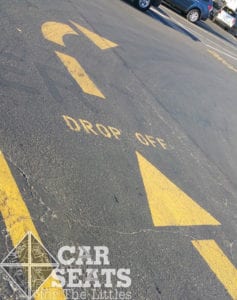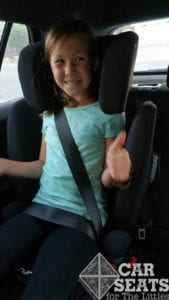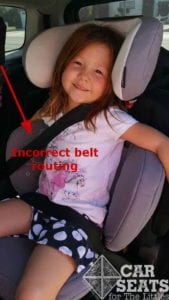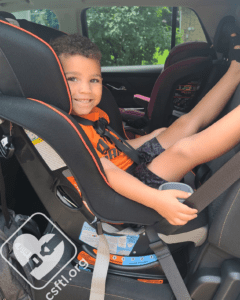
Tales from the School Dropoff Line
Our daughter’s elementary school was a place where parents would park their cars and then walk children into school. However, they recently opened an optional dropoff line. I’m grateful that it’s optional because some days, getting my kiddo out of the car takes quite a while. There are stray Lego pieces to grab, snacks to throw into her backpack, and the not-that-rare need to slither out of her booster, then ask for help when she’s stuck in an unwieldy position. So we need that time.
Other families have swiftly moving children so they’re able to take advantage of the line. A couple of teachers staff the dropoff line, waiting patiently to extricate children as their parents roll up.
One morning, I found myself hanging out with those teachers, where I caught a very enlightening glimpse into the wide variety of misuse and less than safe practices that go on. I’m highlighting a few of them in the hopes that by doing so, we can help more families keep their elementary school aged kiddos safer on the way to school!
Best Practice: Shoulder Belt Guide

Shoulder belt
On high back boosters, the plastic piece in the headrest is a shoulder belt guide. The idea is to thread the vehicle’s seat belt through this guide and it will remain in place. On a booster, the shoulder belt should be just above the child’s shoulder and lay across the middle of their collarbone. This placement positions the belt over the strongest point of the child’s shoulders.
Combined with a lap belt that lays across the child’s hips or top of the child’s thighs, this places the vehicle belt over the 3 strongest points of the child’s body and offers the most protection.
What I Saw
My few minutes in the dropoff line showed some common errors:
- Not using the belt guide at all. This routed the shoulder belt over the middle of the booster headrest in some cases. The belt sometimes wound up somewhere near the child’s shoulder but more often, it placed the belt on the child’s neck.

Nuna AACE 10 years old
- The booster seat’s headrest below the child’s head. As the child grows, high back booster seats can grow along with them! Most booster headrests are raised via a handle either at the top or back of the headrest.

Booster seat wrong seat belt routing
- The seat belt routed through the wrong place on the booster seats. All booster seats have some type of indicator to show where the seat belt belongs.
Young Children Riding in Booster Seats
My shift in the line showed students far too young rolling up in booster seats. We always advocate that children ride in a harnessed car seat until they’re at least 5 years old. Why? Here are a few reasons:
- Children under age 5 aren’t always ready for the challenge of sitting properly.
- Children under age 5 have bones that aren’t strong enough to withstand crash forces using a seat belt alone. A harnessed car seat spreads the force across the child, while a booster seat on a young child risks internal injuries that can be lethal.
Children Riding in the Front Seat
Our friends at NHTSA are very clear on this: the back seat is the safest place for a child to ride. That’s because they’re more protected back there! It’s further from the engine compartment, offers more space between most crashes (rear or frontal), doesn’t have a frontal airbag that can harm a child, and doesn’t have distractions like the heating and radio encouraging a young child to wiggle around. Until a child is at least 13 years old, the safest place remains the back seat.
Children With No Boosters at All
We live in California, where the law first requires children to ride in a harnessed car seat, then a booster seat until they are 8 years old or 4 feet 9 inches tall, then continue to use a booster until the seat belt fits appropriately. Translated: by law, second or third graders and their younger friends need to be in a booster or harnessed car seat. Of course, we advocate that children ride in a booster seat until they pass the Five Step Test. Often, that’s somewhere between 10-12 years old.
Unbuckling While in Motion
The driving factor in the dropoff line is to keep the line moving at all costs. This results in kiddos unbuckling themselves while the car is in motion. There are some mitigating circumstances — the vehicle is moving quite slowly by this point, the kiddo needs to get out ASAP — but under none of these circumstances would we recommend this practice.
Questionable Driving Choices
I’m not here to tell anyone how to do much of anything in their lives, though I’m happy to make experience-based suggestions around best practice when it comes to passenger safety. But I’m about to share a couple of unique things that seem worthy of a mention.
Inventing a Lane (Not Recommended)
My kiddo’s school is at the very end of a narrowish road with TWO LANES. The right lane invariably gets backed up at dropoff time because it feeds into the dropoff line. There is also quite a lot of pedestrian traffic that involves tiny children in the same area at that time. I am always on alert, waiting for a kiddo to dart into the road, drop something as they cross, or somehow surprise me in a bad way so I just wait in that line until it’s my turn. That doesn’t work for some families so they invent a 3rd lane and drive down the middle of an already-narrow road.
Stoping in an Unsafe Location
(Not Recommended)
This is another scenario that seemed kind of obvious to me so I was genuinely surprised the first time I saw it happen. Spoiler: today, I am no longer surprised though I do remain disappointed and nervous about it.
Please pull up safely to the curb in front of the school when dropping off your precious cargo. Do not stop in the middle of a congested road to let your child out of the vehicle.
Bonus Misuse
Since our school includes a preschool, my time in the dropoff line revealed some additional struggles with harnessed car seats.
Forward Facing Too Soon
A rear facing car seat is safer than a forward facing seat, especially for kids under 2. In our ideal CSFTL world, all children ride rear facing until close to their 4th birthdays.
Harness Loose/Chest Clip too Low

Chest Clips
For maximum safety, a 5 point harness should pass the pinch test. It should not be so loose that a cringing CSPT in the dropoff line can’t see a harness strap on the child at all. Along with this, the chest clip should be on the child’s chest, not on the belly.
Top Tether Not Attached
The top tether is a crucial piece of your child’s forward facing car seat. A tether keeps the top of the child’s car seat back an additional four to six inches during a crash. By simply attaching the top tether on forward facing seats, harnessed car seats can offer even more protection and make children less likely to suffer head and neck injuries in a crash.
Moving Forward
Take a moment to review your family’s dropoff line habits and see if any of these tips might improve your family’s safety. As always, we suggest that families meet with a local CPST who can offer installation, configuration, and seat setup advice. We rarely see seat check appointments for families who have booster riders, yet this age group has the largest number of injuries proportionally. We’d love to see an influx of caregivers looking for help with their child’s booster seat!
Whether or not a there’s a CPST local to you, take a few minutes to read the manual for your child’s seat and make any adjustments needed for comfort, fit, and ease of use.



